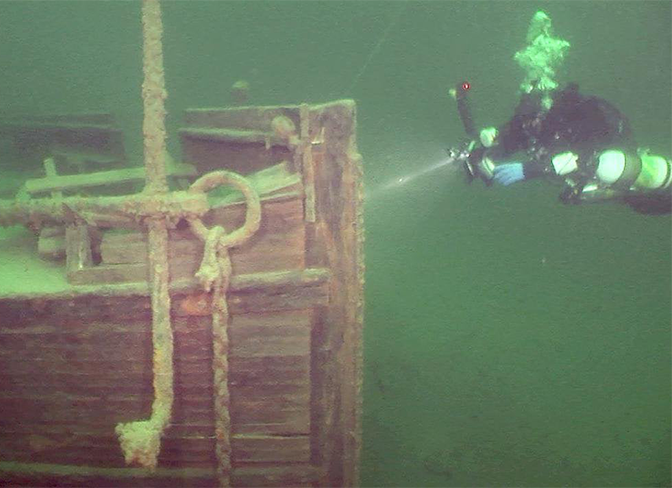The Making of Shipwreck Adventures Home
Creating a New Museum Experience
An Overview of Shipwreck Adventures
Inspiring Play: The Story of the J.S. Seaverns Shipwreck
When senior exhibit developer Mary Weiland landed on the concept of a sunken ship for the new Shipwreck Adventures exhibit, she knew she had a lot of research ahead of her. She began looking into real ships that had gone down in Lake Superior, hoping to find a compelling story to use as inspiration. When she came across an article about a recently discovered shipwreck and realized that it checked all the boxes she was looking for, she knew she had found her inspiration.

Historic photo of the J.S. Seaverns. Photograph courtesy of the C. Patrick Labadie Collection / Thunder Bay National Marine Sanctuary, Alpena, MI.
The Story of the J.S. Seaverns
The J.S. Seaverns was a 130-foot steam barge that regularly carried food, building supplies and passengers to ports across Lake Superior. One night in May 1884, after unloading supplies in a Canadian port on the northeast coast of Lake Superior, the ship hit a rock as it backed away from the dock and began sinking. The crew tried its hardest to save the ship, but were unsuccessful and the ship sank to the bottom of Michipicoten harbor. Thankfully, the entire crew and all of the ship’s passengers survived.
The J.S. Seaverns was long forgotten and actually misidentified on a number of maps. Despite these challenges and over a decade of research, the ship was found in the summer 2016. A group of five shipwreck enthusiasts and conservationists, including Ken Merryman, discovered the wreck after less than a day of searching Lake Superior – a surprisingly short amount of time. Despite being underwater for more than 130 years, the team found the vessel in good condition. In fact, the ship was so well preserved that the hull was still intact, dishes were stacked on the shelves and chairs were arranged in the rooms of the ship, ready to be used by the crew.
Bringing in the Expert
Ken Merryman, one of the founders of the Great Lakes Shipwreck Preservation Society, was instrumental in the creation of Shipwreck Adventures. He and Mary communicated regularly during the early stages of the design process as they went back and forth discussing details to make aspects of the ship more realistic and accurate. Throughout the entire process, Ken was generous with his time and materials, sharing dive footage, 3D renderings of the ship and other detailed resources to show what the ship looked like before it sank.
Thanks to Ken’s insights and recommendations, the ship in the exhibit contains details that bring it to life in ways that only a shipwreck expert could.

Image courtesy of Ken Merryman

Ken Merryman and Mary Weiland during one of their many exhibit planning discussions.
Here are some of the places where visitors can find Ken’s influence and inspirations in the exhibit:
- Pilot House – In original designs of the ship, visitors would encounter the ship’s wheel in isolation, lying on the floor of the lake near the ship hull. Ken pointed out that ships like the J.S. Seaverns actually had pilot houses that housed the wheels, so the designs were updated to include this new area of the ship for visitors to explore. Ken supplied images of pilot houses from ships like the J.S. Seaverns that the team used for design inspiration.
- Uncanny Galley – This area in the ship hull is based on the real galley in the J.S. Seaverns, most of which is still intact underwater today. Through extensive meetings and review of the video footage of the J.S. Seaverns shipwreck, Ken explained exactly how the galley came to settle on the floor of Lake Superior and advised the team about incorporating design details.
- Ship Hull – Ken shared his extensive knowledge about ships to assist the team in understanding the design and fabrication of 19th century steam barges. Although the exhibit does not recreate the hull of the J. S. Seaverns, Ken helped identify the places where the team could recreate certain authentic details. Design and fabrication details like the angles of wood pieces, the layout of the ship hull and identifying typical supply containers that were used during this time period all benefitted from Ken’s expertise.

